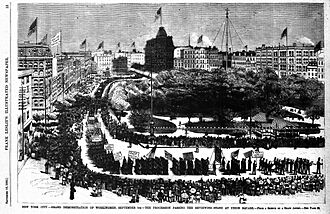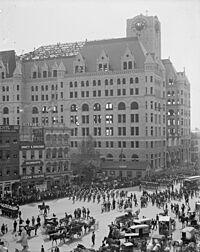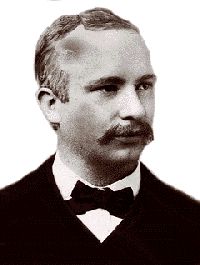Labor Day facts for kids
Quick facts for kids Labor Day |
|
|---|---|

Labor Day Parade in New York's Union Square, 1882
|
|
| Observed by | United States |
| Type | National |
| Celebrations | Parades, food of different cultures and barbecues. |
| Date | First Monday in September |
| 2024 date | September 2 |
| 2025 date | September 1 |
| 2026 date | September 7 |
| 2027 date | September 6 |
| Frequency | Annual |
| Related to | Labour Day |
Labor Day is a federal holiday in the United States that is celebrated on the first Monday of September. It's a special day to honor and thank American workers for all they have done to help the country grow and succeed. The holiday is also a chance for families and friends to enjoy the end of summer with parades, picnics, and barbecues.
Canada also celebrates its Labour Day on the first Monday of September. However, most other countries celebrate workers on May 1, which is known as International Workers' Day.
Contents
The Story of Labor Day
Where Did the Idea Come From?
In the late 1800s, many Americans worked very long hours in difficult conditions. To get better pay and safer workplaces, workers began to form groups called trade unions. These groups decided that there should be a special day to celebrate the contributions of workers.
There are a couple of stories about who first came up with the idea for Labor Day.
- One story gives credit to Matthew Maguire, a leader in New York's Central Labor Union. After a big parade for workers in September 1882, he suggested that the first Monday of September should become a national holiday for workers.
- Another story says the idea came from Peter J. McGuire, a co-founder of the American Federation of Labor. He suggested a holiday that would start with a parade to show the strength of workers, followed by a picnic for families to enjoy. He thought the first Monday in September was the perfect time, right between the Fourth of July and Thanksgiving.
No matter who thought of it first, the first Labor Day parade was held in New York City on September 5, 1882.
Making It an Official Holiday
The idea of Labor Day quickly became popular all over the country. In 1887, Oregon was the first state to make it an official holiday. By 1894, thirty states were already celebrating it.
That same year, after a large railroad workers' strike called the Pullman Strike, the U.S. Congress passed a bill to make Labor Day a national holiday. President Grover Cleveland signed the bill into law on June 28, 1894. Today, every state and territory in the U.S. celebrates Labor Day.
Why September and Not May?

Around the world, more than 150 countries celebrate workers on May 1. This day is often called International Workers' Day or May Day. This date was chosen because of a major workers' protest for an eight-hour day that happened in Chicago in May 1886. This event is known as the Haymarket affair.
In the United States, some people wanted to celebrate on May 1, too. However, President Grover Cleveland was worried that a holiday on May 1 would remind people of past conflicts and protests. He and others felt that the September date was a better choice for a peaceful celebration of workers. So, in 1894, he signed the law making the first Monday in September the official Labor Day.
More Than Just a Day Off: The End of Summer
Labor Day is often called the "unofficial end of summer." It's the last big holiday weekend before autumn begins. For many people, it marks a time of change.
Back to School and Sports
Many schools across the country start up again right around Labor Day. Some start the week before, making it the first three-day weekend of the school year. Others wait until the Tuesday after the holiday.
Fall sports also kick off around this time. College football teams usually play their first games, and the National Football League (NFL) season begins the Thursday after Labor Day. Big car races and tennis tournaments also take place over the weekend.
Parades, Picnics, and Fashion
Labor Day is a time for parades, picnics, and barbecues with family and friends. Many cities have special events. For example, New York has the Labor Day Carnival, and Washington, D.C., has a free concert at the U.S. Capitol.
There is also a fun, old fashion rule that says you shouldn't wear white clothes after Labor Day. This tradition started a long time ago when wealthy people would pack away their light-colored summer clothes after returning from their summer vacations. Today, many people don't follow this rule, but it's still a well-known saying.
A Big Weekend for Shopping
Because so many people have the day off, Labor Day weekend is a huge time for shopping. Stores offer big discounts and sales, especially on things for going back to school. It is one of the biggest shopping weekends of the year, similar to Black Friday during the Christmas season.
See also
 In Spanish: Labor Day para niños
In Spanish: Labor Day para niños


